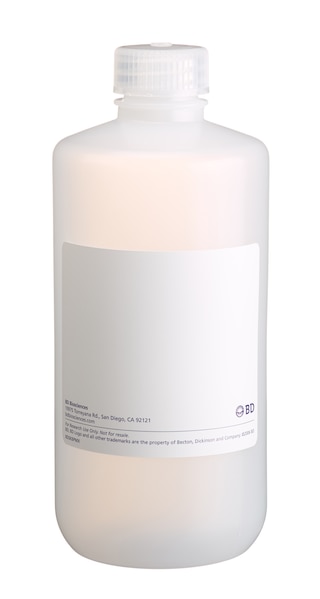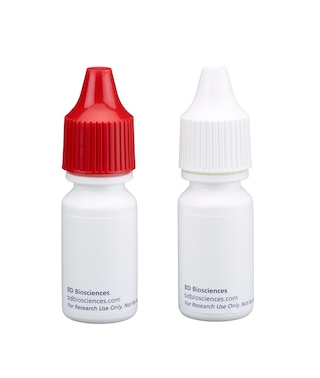Old Browser
This page has been recently translated and is available in French now.
Looks like you're visiting us from {countryName}.
Would you like to stay on the current country site or be switched to your country?
BD Pharmingen™ Mouse Naive/Memory T Cell Panel
(RUO)



Multicolor flow cytometric analysis of naïve and memory CD4+ T cell subsets defined by the coexpressed levels of CD62L and CD44. Splenocytes from a young (4 weeks) or older (9 weeks) BALB/c mouse donor were stained for analysis using the FACSCalibur™ System (Top Figures) with a combination (5 μl each) of PerCP-Cy™5.5 Rat Anti-Mouse CD4, PE Rat Anti-Mouse CD44, and APC Rat Anti-Mouse CD62L. Splenocytes were also stained with APC-Cy™7 Rat Anti-Mouse CD3 Molecular Complex, then analyzed on the BD™ LSR II and FACSCanto™ II systems (Middle and Bottom Figures, respectively). Two-color flow cytometric dot plots showing the expression of CD62L and CD44 (right dot plots) were derived from CD4+ cells (middle histograms) with the light scattering characteristics of viable lymphocytes (left FACSCalibur dotplot) or viable CD3+ cells (left LSR II and FACSCanto II dotplots). FSC vs SSC data from multiparameter analysis using the LSR II and FACSCanto II were also used for gating viable cells (data not shown). The patterns for the coexpressed levels of CD62L and CD44 by CD4+ T cells from the same young BALB/c mouse donor were very similar as determined by the 3 different flow cytometer systems (right dot plots). Interestingly, multicolor flow cytometric analysis of spleen cells from an older BALB/c mouse donor (far right dot plot from FACSCanto II analysis) revealed a significantly altered coexpression pattern of CD62L and CD44 by CD4+ T cells.


BD Pharmingen™ Mouse Naive/Memory T Cell Panel

Mouse Naive/Memory T Cell Panel
Regulatory Status Legend
Any use of products other than the permitted use without the express written authorization of Becton, Dickinson and Company is strictly prohibited.
Description
Note: The panel is 50 test size. Extra material for each component for an additional 10 tests is provided for instrument set up purposes.
The antibodies are supplied in an aqueous buffered solution containing BSA, protein stabilizer, and ≤ 0.09% sodium azide.
Multicolor immunofluorescent staining followed by flow cytometric analysis and sorting has led to the phenotypic and functional characterization of multiple peripheral T cell subsets. Three major T cell subsets have been well characterized, i.e., naïve, memory and effector T cells. Naïve mouse T cells have a relatively homogenous cell surface phenotype. They express high levels of the peripheral lymph node homing receptor, CD62L (L-selectin), and low to intermediate levels of the adhesion molecule, CD44 (Pgp-1). Effector T cells coexpress variable to low levels of CD62L and high CD44 levels whereas memory T cells coexpress variable to high levels of CD62L and high levels of CD44. The Mouse Naive/Memory T Cell Panel contains fluorescent antibodies (each optimized at 5 μl per test) that are specific for the cell surface antigens: CD44, CD62L, CD4 and CD3. The panel was designed to standardize the multicolor staining and flow cytometric characterization of the three major CD4+ T cell subsets that arise as a consequence of development or clonal expansion and differentiation driven by antigenic stimulation (eg, in response to allergens, infectious disease or vaccination).
This fluorescent antibody panel was flexibly designed to permit the researcher's incorporation of FITC- or Alexa Fluor® 488-conjugated antibodies/probes or cells expressing green fluorescent proteins into flow cytometric analysis of mouse T cell subsets.
Preparation And Storage
Product Notices
- This reagent has been pre-diluted for use at the recommended Volume per Test. We typically use 1 × 10^6 cells in a 100-µl experimental sample (a test).
- Source of all serum proteins is from USDA inspected abattoirs located in the United States.
- Caution: Sodium azide yields highly toxic hydrazoic acid under acidic conditions. Dilute azide compounds in running water before discarding to avoid accumulation of potentially explosive deposits in plumbing.
- For fluorochrome spectra and suitable instrument settings, please refer to our Multicolor Flow Cytometry web page at www.bdbiosciences.com/colors.
- Please observe the following precautions: Absorption of visible light can significantly alter the energy transfer occurring in any tandem fluorochrome conjugate; therefore, we recommend that special precautions be taken (such as wrapping vials, tubes, or racks in aluminum foil) to prevent exposure of conjugated reagents, including cells stained with those reagents, to room illumination.
- PerCP-Cy5.5–labelled antibodies can be used with FITC- and R-PE–labelled reagents in single-laser flow cytometers with no significant spectral overlap of PerCP-Cy5.5, FITC, and R-PE fluorescence.
- PerCP-Cy5.5 is optimized for use with a single argon ion laser emitting 488-nm light. Because of the broad absorption spectrum of the tandem fluorochrome, extra care must be taken when using dual-laser cytometers, which may directly excite both PerCP and Cy5.5™. We recommend the use of cross-beam compensation during data acquisition or software compensation during data analysis.
- This product is subject to proprietary rights of Amersham Biosciences Corp. and Carnegie Mellon University and made and sold under license from Amersham Biosciences Corp. This product is licensed for sale only for research. It is not licensed for any other use. If you require a commercial license to use this product and do not have one return this material, unopened to BD Biosciences, 10975 Torreyana Rd, San Diego, CA 92121 and any money paid for the material will be refunded.
- This APC-conjugated reagent can be used in any flow cytometer equipped with a dye, HeNe, or red diode laser.
- APC-Cy7 is a tandem fluorochrome composed of Allophycocyanin (APC), which is excited by laser lines between 595 and 647 nm and serves as an energy donor, coupled to the cyanine dye Cy7™, which acts as an energy acceptor and fluoresces at 780 nm. BD Biosciences Pharmingen has maximized the fluorochrome energy transfer in APC-Cy7, thus maximizing its fluorescence emission intensity, minimizing residual emission from APC, and minimizing required electronic compensation in multilaser-laser flow cytometry systems. Note: Although every effort is made to minimize the lot-to-lot variation in residual emission from APC, it is strongly recommended that every lot be tested for differences in the amount of compensation required and that individual compensation controls are run for each APC-Cy7 conjugate.
- APC-Cy7 tandem fluorochrome emission is collected in a detector for fluorescence wavelengths of 750 nm and higher.
- Warning: Some APC-Cy7 and PE-Cy7 conjugates show changes in their emission spectrum with prolonged exposure to formaldehyde. If you are unable to analyze fixed samples within four hours, we recommend that you use BD™ Stabilizing Fixative (Cat. No. 338036).
- Cy is a trademark of GE Healthcare.
- Please refer to www.bdbiosciences.com/us/s/resources for technical protocols.
Companion Products


| Description | Quantity/Size | Part Number | EntrezGene ID |
|---|---|---|---|
| PE Rat Anti-Mouse CD44 | 60 Tests (1 ea) | 51-9007324 | N/A |
| PerCP-Cy™5.5 Rat Anti-Mouse CD4 | 60 Tests (1 ea) | 51-9007325 | N/A |
| APC Rat Anti-Mouse CD62L | 60 Tests (1 ea) | 51-9007326 | N/A |
| APC-Cy™7 Rat Anti-Mouse CD3 Molecular Complex | 60 Tests (1 ea) | 51-9007327 | N/A |
Development References (6)
-
Baaten BJ, Li CR, Deiro MF, Lin MM, Linton PJ, Bradley LM. CD44 regulates survival and memory evelopment in Th1 cells. Cell. 2010; 32(1):104-115. (Biology). View Reference
-
Bjorkdahl O, Barber KA, Brett SJ, et al. Characterization of CC-chemokine receptor 7 expression on murine T cells in lymphoid tissues. Immunology. 2003; 110(2):170-179. (Biology). View Reference
-
Boyman O, Letourneau S, Krieg C, Sprent J. Homeostatic proliferation and survival of naive and memory T cells. Eur J Immunol. 2009; 39(8):2088-2094. (Biology). View Reference
-
Budd RC, Cerottini JC, Horvath C, et al. Distinction of virgin and memory T lymphocytes. Stable acquisition of the Pgp-1 glycoprotein concomitant with antigenic stimulation. J Immunol. 1987; 138(10):3120-3129. (Biology). View Reference
-
Ernst DN, Weigle WO, Noonan DJ, McQuitty DN, Hobbs MV. The age-associated increase in IFN-γ synthesis by mouse CD8+ T cells correlates with shifts in the frequencies of cell subsets defined by membrane CD44, CD45RB, 3G11, and MEL-14 expression. J Immunol. 1993; 151(2):575-587. (Biology). View Reference
-
Lee WT, Vitetta ES. The differential expression of homing and adhesion molecules on virgin and memory T cells in the mouse. Cell Immunol. 1991; 132(1):215-222. (Biology). View Reference
Please refer to Support Documents for Quality Certificates
Global - Refer to manufacturer's instructions for use and related User Manuals and Technical data sheets before using this products as described
Comparisons, where applicable, are made against older BD Technology, manual methods or are general performance claims. Comparisons are not made against non-BD technologies, unless otherwise noted.
For Research Use Only. Not for use in diagnostic or therapeutic procedures.
Report a Site Issue
This form is intended to help us improve our website experience. For other support, please visit our Contact Us page.
